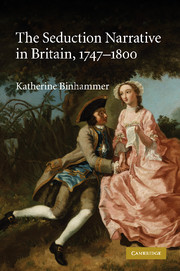Book contents
- Frontmatter
- Contents
- Acknowledgments
- Introduction
- 1 Knowing love: The epistemology of Clarissa
- 2 The whore's love or the Magdalen's seduction
- 3 After knowledge: Married heroines and seduction
- 4 Seduction in street literature
- 5 Melodramatic seduction: 1790s fiction and the excess of the real
- Notes
- Bibliography
- Index
4 - Seduction in street literature
Published online by Cambridge University Press: 18 February 2010
- Frontmatter
- Contents
- Acknowledgments
- Introduction
- 1 Knowing love: The epistemology of Clarissa
- 2 The whore's love or the Magdalen's seduction
- 3 After knowledge: Married heroines and seduction
- 4 Seduction in street literature
- 5 Melodramatic seduction: 1790s fiction and the excess of the real
- Notes
- Bibliography
- Index
Summary
“My fortune is not equal to your merit,” declares the reformed aristocratic seducer of “Virtue in Distress” (1770) as he proposes to Eliza, a beautiful and virtuous humble laborer. The sentiment that a woman's individual merit provides her with a dowry out-valuing the money of a man of fortune becomes newly comprehensible within the later eighteenth-century's affective landscape. When individual feeling takes precedence over traditional kinship structures in uniting love with marriage, laboring-class women are theoretically poised to profit the most from companionate marriage's implied revolutionary economics. Samuel Richardson's infamous Pamela (1740) was the first text to turn the Cinderella fairy tale into a realistic narrative in which a laboring-class heroine's virtue could be rewarded with both the love and the hand of her upper-class seducer. Though the story, as historians have demonstrated, was not grounded in probable reality, the ‘virtue rewarded’ narrative becomes newly recognizable as a mimetic tale. This chapter focuses on seduction narratives that have poor heroines but ones that, unlike Pamela, circulated within street literature, and asks what function the repetition of seduction serves when it is directed at a laboring-class readership. What happens to Pamela's story when it is told not within a sentimental novel but in prose narrative chapbooks and in popular ballads? Two major differences appear when we turn from novels to cheap print: one, the plot of seduction in street literature does not easily or always follow the path of virtue rewarded with marriage but includes non-sentimental comic and tragic tellings; and two, the narratives are primarily told from third-person, not first-person, perspectives.
- Type
- Chapter
- Information
- The Seduction Narrative in Britain, 1747–1800 , pp. 108 - 137Publisher: Cambridge University PressPrint publication year: 2009



